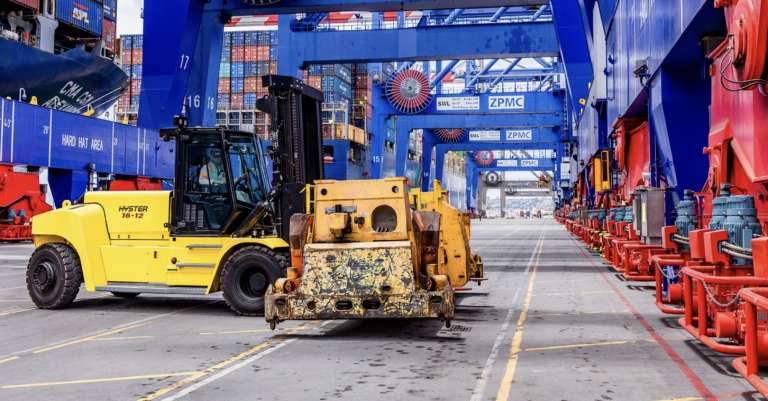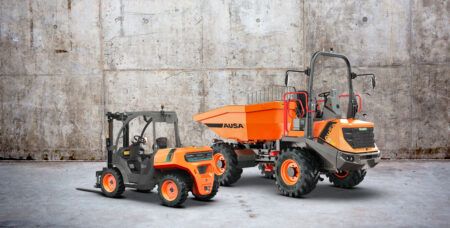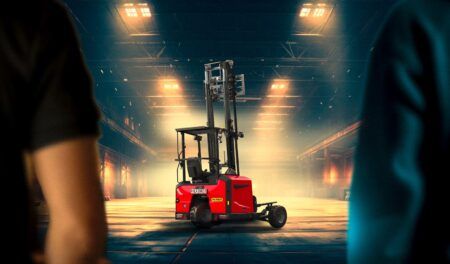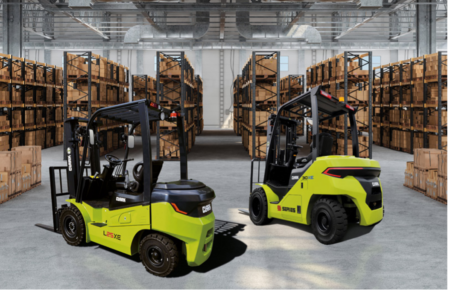Hyster has announced its 10-18 tonne lift capacity trucks are now available with an electric drivetrain, helping businesses achieve zero-emissions objectives by making the switch to electric forklifts.
The new Hyster J10-18XD lift trucks lift up to 18-tonnes and feature lithium-ion battery packs providing full power and acceleration, comparable to a diesel forklift but with no emissions.
The new big trucks are also intelligently designed to prevent overheating, uniquely combining liquid cooled motors and inverters with 350 Volt lithium-ion batteries. The high voltage and low current system featured in the new trucks not only greatly reduces heat development, but also incorporates specially designed water-cooled motors and drive controllers to further prevent heat build-up. Battery monitoring systems also help to control under and overcharging.
“This is a breakthrough for businesses in heavy industry that are keen to achieve green objectives in factories, warehouses and yards,” says Jan-Willem van den Brand, director global market development, big trucks, for Hyster. “With support from Hyster, the transition to clean electric power is now simpler than ever and comes with no compromise on performance or efficiency.”
Whether the trucks are used to unload steel bars from a train, feed concrete moulds into a manufacturing process, or transport wood-based panels through a manufacturing site, the new Hyster electric trucks may provide even better productivity than a diesel alternative. The quiet and comfortable cabin also improves the driver experience, alongside outstanding visibility, ergonomics, and productivity-enhancing features.
Whether the trucks are used to unload steel bars from a train, feed concrete moulds into a manufacturing process, or transport wood-based panels through a manufacturing site, the new Hyster electric trucks may provide even better productivity than a diesel alternative. The quiet and comfortable cabin also improves the driver experience, alongside outstanding visibility, ergonomics, and productivity-enhancing features.
“Regardless of if the truck is used for periodic or continuous operation, you can drive these trucks like a diesel,” says Jan-Willem, explaining that as with an IC-powered Hyster Big Truck, the new electric models provide exceptional traction power, acceleration and drawbar pull.
However, matched with the right application and operating intensity, the Hyster J10-18XD lift trucks may also help operations to reduce the Total Cost of Ownership.
The integrated lithium-ion batteries produce higher performance than lead-acid counterparts and have a longer life cycle, helping to keep costs down. Plus, each truck can be equipped with modular battery packs to store the necessary power required to meet the operational needs. The system is optimally designed for high power opportunity charging, removing the need to swap batteries, so uptime is maximised, and shift changes and breaks become productive. The new truck option requires just 11 minutes of charge for up to one hour of work.
“With less time needed for charging, a wide range of applications can benefit from greater truck availability,” says Jan-Willem. “Operations with two or three shift operations can easily top up the charge, preventing the need for battery exchange and a separate charging room. As the battery and electric motor are maintenance free this also helps reduce costs, further contributing to a low cost of ownership.”
To support businesses in their journey from a diesel to an electric fleet, Hyster works closely with operations to plan the transition, providing options that enable the correct electric lift truck to be configured for differing application needs. The experts at Hyster also advise on the necessary changes to electrical and infrastructure needs, plus a suitable charging strategy and process. Further support is given through training and servicing throughout the lifetime of the lift truck.
“Green objectives are also important to many businesses, some of which are exploring the implementation of solar panels and other onsite methods of generating electricity. In many countries there are also tax incentives and grants that support companies looking to invest in zero-emissions equipment,” says Jan-Willem. “These types of applications will find these new trucks an ideal choice when compared to diesel, both environmentally and economically.”





